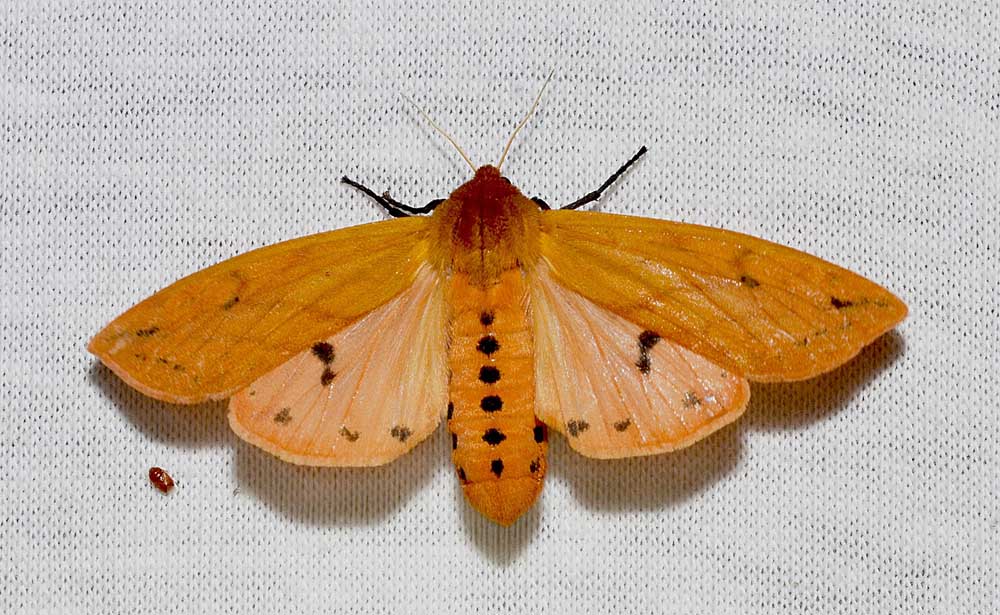Coast Chronicles: The umwelt of little things
Published 9:39 am Monday, September 26, 2022

- A tiger moth results from the metamorphosis of a caterpillar.
The limitation of human senses
I guess there’s no argument now that weather-guru Cliff Mass has weighed in and we have passed the fall equinox. We are solidly into Indian summer days; fall is upon us. But I knew weeks ago when the sound of the wind changed. Those dry leaves, now starting to gold-up, just rustled differently when the breezes blew in off the bay. And aren’t the tidelands just a little bit saltier as the waters pull back on some of these dramatic tidal shifts?
Our little bubble of senses — smells, sights, sounds — are what scientists call our umwelt, our self-centered world. That is, all the sensations we’re able to perceive or experience around us. It’s a German word (they’re so good at these psychological terms) — in English pronounced umvelt — to describe each organism’s set of unique sensory abilities.
“Self-centered” is especially appropriate for describing human senses because we’re so definitively caught in our own ideas about what’s going on around us. In fact, we even took to measuring the intelligence of other species by comparing them to our own (limited) perceptions and equipment. It took us decades to understand that the Great Apes had the capacity for language, not because they didn’t have the brain power but because they didn’t have the vocal structures we do. Then some smart scientists began using sign language — and voila! — now we can “talk” to those amazing mammals so genetically close to us on the evolutionary tree.
Same problem with whales or dolphins. Now we know they not only have communication systems — specific to regions and pod-groupings — but, seemingly, names for each other. Plus they can broadcast ideas across miles in their watery world and cooperate on hunting and childrearing.
Every creature has an umwelt
There are so many more examples of umwelt in Ed Yong’s book “An Immense World, How Animal Senses Reveal the Hidden Realms Around Us.” He writes about insects, reptiles, fish, birds and other mammals with extraordinary powers of perception. Some creatures have “eyes on their genitals, ears on their knees, noses on their limbs and tongues all over their skin” as Terry Gross says in an interview with Yong (freshairarchive.org/guests/ed-yong).
We’re lacking in so many areas. OK, so we were lucky enough to have developed oversized brains along with these oh-so-handy opposable thumbs. But so far as I can see that has only made us a danger to ourselves and others. Maybe that’s why I often evangelize about the other creatures sharing our world. Like, lately, I’ve been paying attention to the female orb spiders who arrive every autumn; they’re at it again, weaving big beautiful circular webs in order to capture food, mate, then lay their eggs.
Humbleness is in order. The world is in constant flux and the animals, insects and birds all around us are magnificent and spectacular even when they don’t look like they’re doing much of anything. Robins can hear worms digging and moving through the soil. Imagine!
Yong writes that many insects have the power to see ultraviolet light — something just out of our human range. In fact, humans are the minority in the animal/insect world in not being able to perceive UV light. Bees, for instance, are able to see not only the many colors of the flowers we love but also the UV bullseye patterns that direct them — boom! — to exactly where the pollen is. So I’m assuming those orbs spiders probably have this same UV perception; as well as their remarkable architectural engineering abilities.
One of my yard’s orb spiders has somehow attached a structural line 12 feet above her on the eave of my garage and the others to a ground-level rosemary bush. (They need three such lines to begin their circular web of sticky silk.) They rebuild their webs every day. Consuming the old one, then resting, then beginning again. They don’t want that old net to catch detritus and thus give their web away to their prey. What a life!
A hero’s journey
And the woolly bears are just appearing in our grassy fields and meadows. As we know, they leave their fuzzy bodies behind and turn into golden spotted tiger moths, certainly a transformative tale for the ages. Talk about umwelt — I wonder how that must feel to a woolly bear: to completely lose ones’ self, totally liquefy, and then be transformed into a tiny elegant thing with wings. Now that’s a hero’s journey!
Dragonflies, though fewer in number than in past years, have also appeared, particularly around water and cattails. Factoids: they have eyes all over their heads; some can fly 35 mph; they’re older than dinosaurs (some dragonfly fossils are 240 million years old); ancient dragonflies were as big as crows. (Factoids here: tinyurl.com/bdf59dds.)
Leaf hoppers make vibrations with their abdomens, and, as Yong says, “If you were to clip a small mic onto them what you’d hear is out of this world, like nothing we’d think an insect would or even could make. It’s like musical instruments or bird songs. And even the plants themselves are vibrating, so there’s this whole world of sound all around us that we have absolutely no knowledge of.”
The world’s ginormous variety
Our human umwelt bubbles start to feel just a little bit smaller when compared to those of other creatures. Or maybe there’s another way to look at it. Perhaps it’s just a reminder that what we may think is familiar can be seen as newly wonderous. When I walk with Jackson on the paths we’ve traversed a hundred times, it’s same old/same old. But then I watch him thrill at all that’s new every day: he demands that we stop so he can smell intently one blade of grass. (Scientists think a dog’s sense of smell is somewhere between 10,000 to 100,000 times more acute than ours.) So though I may think the walk is ordinary, Jackson’s umwelt provides him a vast world of variety.
Humbleness is in order. The world is in constant flux and the animals, insects and birds all around us are magnificent and spectacular even when they don’t look like they’re doing much of anything. Robins can hear worms digging and moving through the soil. Imagine!
Yes, we have consciousness, which seems to be a pretty special and complicated talent. But let us not judge the value of earth’s creatures based on a comparison with our senses. We might find that we’re on the lower rungs of the evolutionary perception ladder. Yong hopes his and others’ research will encourage us to broaden our imaginations, to realize the magnificence of nature is all around us in the tiniest of creatures.
•••
Now, though, how about taking advantage of the human umwelt we do have: after a covid hiatus, the Water Music Festival is back — Oct. 14-15-16! As Water Music Chair Diana Marshall says, “This year’s Festival is one for the record books. I’m truly excited about the variety of concerts and the world-class artistry at each concert — from a Phantom of the Opera theater piece (Kari Burgess, soprano; David Gustafson, tenor; and John Jantzi, pianist) to brilliant classical guitarist Paul Galbraith, who’s been described as a ‘majestic performer,’ to Tien Hsieh, one of the most impressive classical pianists in the world!”
Don’t miss this slate of exceptionally talented musicians gracing our Peninsula — it’s a range of sound that our human ears are best suited for! And don’t forget that your ticket not only allows you to be up close and personal with spectacular live music, but it also supports music programs in our schools. For information and tickets: watermusicfestival.com.









